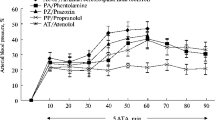Abstract
Experiments on waking dogs and dogs anesthetized by intravenous injection of chloralose (60–80 mg/kg) showed that chloralose has practically no effect on most indices of the oxygen transport function of the blood and produces only a very slight decrease in the oxygen saturation of the arterial blood and the minute oxygen transport by the arterial blood. The O2 consumption is reduced by a greater degree; the balance between the O2 supplied by the blood and its consumption by the tissues of the body is thereby unaffected. The results indicate that chloralose, given in the dose usually used experimentally, does not give rise to any manifestations of oxygen insufficiency such as are frequently observed when other general anesthetics are given.
Similar content being viewed by others
Literature Cited
S. A. Bershtein and N. V. Il'chevich, Fiziol. Zh. (Ukr.),14, 419 (1968).
V. I. Voitkevich, Fiziol. Zh. SSSR,40, 269 (1954).
T. M. Darbinyan and V. B. Golovchinskii, Mechanisms of Anesthesia [in Russian], Moscow (1972).
I. P. Zapadnyuk, V. I. Zapadnyuk, and E. A. Zakhariya, Laboratory Animals, Their Breeding, Care, and Use in Experiments [in Russian], Kiev (1962).
M. M. Seredenko, Age Differences in the Response of the Senile Organism to a Deficiency of Oxygen in the Inspired Air, Candidate's Dissertation, Kiev (1965).
V. V. Turanov, in: Abstracts of Proceedings of a Conference to Celebrate the Eightieth Anniversary of the Birth of Academician A. A. Bogomolets [in Russian], Kiev (1961), p. 236.
G. U. Balis and R. R. Monroe, Psychopharmacologia (Berlin),6, 1 (1964).
J. F. Cier, Compt. Rend. Soc. Biol.,145, 1541 (1951).
F. M. Greisheimer, in: Handbook of Physiology, Section 2, Circulation, Vol. 3, Washington (1965), p. 2477.
F. R. Griffith, F. E. Emery, and J. E. Lockwood, Am. J. Physiol.,131, 561 (1941).
M. Hanriot and C. Richet, Compt. Rend. Soc. Biol.,5, 109 (1893).
F. Jourdan, P. Duchene-Marullaz, and I. Leuson, Compt. Rend. Soc. Biol.,146, 1323 (1952).
G. Ludany, von Naynun-Schmiedebergs, Arch. Exp. Path. Pharmak.,167, 717 (1932).
J. E. Nunn and D. W. Hill, J. Appl. Physiol.,15, 383 (1960).
C. Richet, Arch. Ital. Biol.,21, 266 (1894).
J. W. Severinghaus and C. P. Larsson, in: Handbook of Physiology, Section 3, Respiration, Vol. 2, Ch. 49, Washington (1965), p. 1219.
M. Suskind and H. Rahn, J. Appl. Physiol.7, 59 (1954).
S. M. Tenney, Anesthesiology,17, 82, (1956).
S. Vincent and J. H. Thomson, J. Physiol. (London),65, 449 (1928).
Rights and permissions
About this article
Cite this article
Seredenko, M.M., Il'chevich, N.V. & Bershtein, S.A. Effect of chloralose anesthesia on the oxygen transport function of the blood. Bull Exp Biol Med 78, 1031–1033 (1974). https://doi.org/10.1007/BF00796659
Received:
Issue Date:
DOI: https://doi.org/10.1007/BF00796659



